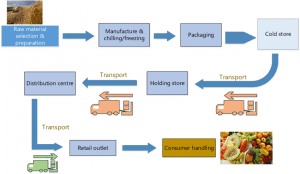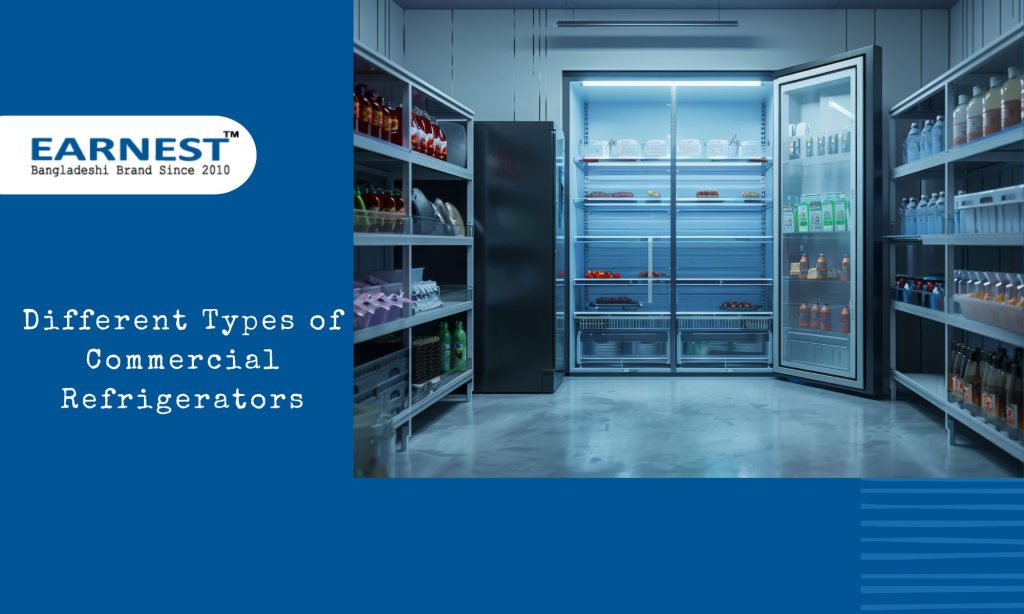Cold Storage Technology offers a cooling solution in a confined environment for preserving various kinds of products across different industries. Industries like – agriculture, processed food, fishery, pharmaceutical, healthcare, etc. are greatly benefited by the cold storage facilities, thus consuming the most prominent share of Cold Storage Technology around the world.
With a market share of 110.2 billion USD and a steeply growing CAGR of 11.6%, cold storage manufacturers are expected to increase significantly in the coming years. Having covered a wide array of services, it’s important to know about Cold Storage Technology and cold storage suppliers in detail.
Construction And Working Of A Cold Storage Plant
At the heart of every cold storage unit are 6 components. These are:
1. Compressor
This is the heart of Cold Storage Technology and the only device that require a constant supply of power. It is used to raise the temperature and pressure of the refrigerant.
2. Condensor
The condenser acts as a heat sink to remove the collected heat from the refrigerant and the circulating water. It helps the refrigerant to change states from gas to liquid at high temperatures and pressure.
3. Receiver
The receiver collects the liquid concentrated refrigerant after it changes its state inside the compressor. On arriving in this component, the liquid expands again and releases the temperature and pressure.
4. Expansion Valve
Using a throttling device, the expansion valve reduces the temperature of the refrigerant which changes the temperature and pressure of the liquid.

5. Evaporator
The evaporator collects the heat from the storage unit and uses it to increase the temperature of the refrigerant. This temperature change creates a vaporizing effect in the liquid refrigerant causing it to release cold gas into the storage unit.
6. Blowers
The blowers help to flow the cold air across the storage unit using the convection process which helps to maintain a constant temperature in the room.
Cold Storage Working Process
To sum up the working process, the refrigerant is passed through the compressor to remove its heat and change it from a gaseous state to a liquid. The compressor applies temperature and pressure on the refrigerant to reduce its boiling point. Due to added pressure, the refrigerant converts from its gaseous state into a liquid state.

Consequently, the refrigerant is transferred to the reservoir and moved slowly to the expansion valve where it loses the temperature in a liquid state.
In the last step, the evaporator collects the heat from the surrounding which again changes the state of the refrigerant from liquid to a gaseous state. This causes the cooling effect which is circulated throughout the freezer using blowers.
Types Of Cold Storage
1. Bulk Cold Storage
Consisting of a large space and often storing a single product, bulk Cold Storage Technology are mainly used to store seasonal products like – potato, chilies, apples, etc.
2. Multipurpose Cold Storage
These storage units are facilitated to store various kinds of products throughout the year. Such as – fruits, vegetables, dairy products, cash crops (pulses, spices), etc.
3. Small Cold Storage
Small cold storage, is often used for preserving food in hotels and restaurants. Besides fruits and vegetables, these units can also be used to store exportable items like – grapes, mangoes, etc.
4. Frozen Food Storage
Frozen food storages are useful for storing semi-processed food items like – fish, meat, poultry, dairy products, processed fruits, vegetables, etc. Such units cover a large portion of all cold storage units globally.
5. Walk-in Cold Storage
These cold storage units are specifically built for food reserves in hotels, restaurants, malls, supermarkets, cruise ships, etc.
6. Controlled Atmosphere Storage
These storages are meant specifically for sensitive chemicals, harvested organs, blood and plasma samples, vaccines, antibiotics, etc.
7. Ripening Chambers
These low-cost setups exist for ripening fruits like – papayas, bananas, and mangoes.
Application Of Cold Storage In Different Industries
Cold storage application is spread out in all kinds of industries such as:
1. Agricultural Industry
Post-harvested agricultural products sum up the most significant part of the cold storage industry. Fruits and vegetables are the frontrunners of all agricultural products.
2. Retail Food Industry
Other forms of organic food are another large part of the cold storage industry that covers semi-processed meat, fish, dairy products, etc.
3. Pharmaceutical Industry
Pharmaceutical industries performing trials and experimentation require cold storage to store blood samples and plasma samples. Additionally, sensitive chemicals such as – insulin, chemotherapy medicines, vaccines, liquid drops, etc. require a constant temperature for storage which calls for a cold storage solution.
4. Chemical Industry
Chemical-dependent industries like – petroleum refineries, chemical plants, paper factories, apparel industries, etc. require a lot of chemicals which sets the need for large cooling systems. Such industries require cooling systems that can be used to condensate and separate gases, dehumidify gases, solvent recovery, etc.
5. Metalwork Industry
The metalwork industry requires cold treatment for metals for specific operations in Cold Storage Technology like – metal tampering. A similar cooling technology, when compared with the chemical industries is also used for the metal industries.
6. Healthcare Industry
With the increased demand for transplants and surgery, the necessity to store specific organs is on the rise. Storing organs requires maintaining a consistently cold temperature under monitored conditions. Besides, skin grafting and tissue replacement are used in plastic surgery that requires storage under controlled temperature as well.
7. Brewery and Winery Industry
Brewery and winery industries depend on proper fermentation to ensure a good taste. Beer requires 8-12C temperature, while wine requires 27-30C temperature for ideal fermentation. Besides, fruit beverages are in high demand nowadays and require a similar temperature for storage.
8. Hospitality Industry
Hotels, restaurants, and resorts host thousands of customers each day which places the need for serving quality food at all times. This calls for a quality Cold Storage Technology unit for storing food and other chemicals to keep them fresh.
Benefits From Cold Storage Technology
Being an integral part of storage solutions, Cold Storage Technology offers a whole array of benefits, especially for developing the growth of a business.
1. Matches All Kinds of Space Requirements for Storage
Any business requires two crucial things for Cold Storage Technology – size adjustment and space availability. Both of these are well covered by most cold storage suppliers around the world. Besides, most cold storage manufacturers offer personalized chambers for storing specifically sized and categorized goods.
2. Ability to Storage Various Items
Normally, all biodegradable items in Cold Storage Technology are stored in three groups.
Group one is for fast decomposable items such as – fruits and vegetables.
Group two is for decomposable items that are processed in some ways such as – meat and fish.
Lastly, group three is focused on shelf products that require a constant temperature such as – cosmetics, tobacco, beer, etc.
3. Retains Food Taste and Nutrients
Maintaining an ideal freezing temperature in Cold Storage Technology and freezing humidity inside the facility prevents freeze burns on the product which prevents dehydration. Additionally, it retains the flavors and taste of the food items while keeping the nutrition values intact.
4. Automated Temperature Adjustment
Nowadays, using sophisticated sensors and IoT-based control systems, factors like – humidity, water leaks, freezer temperature, constant temperature, general alarms, etc. can be automated and maintained easily.
5. Cost-Effective Storage Solution for Biodegradable Items
Using Cold Storage Technology for storing biodegradable products is the best approach to keep your inventory fresh for longer. Ensuring the product longevity gives more profit, thus saving money in the long run.
6. Reducing Waste Management and Loss of Business
Microbes destroy the intactness of a product over time and usually work faster on organic items. So, a well-regulated temperature inside the facility ensures less growth of microbes and protects the integrity of the products.
7. Customized Storage Solution
To reduce waste, offering added storage solutions is a plus. For example – most fruit storage units offer fruit ripening chambers for mangoes, bananas, papaya, etc. Such initiative increases the sale value while ensuring the longevity of your products while also raking in more revenue for the same storage price.
8. Requires Low Maintenance
Nowadays, most storage solutions are automated using IoT which is connected with an app that can be controlled remotely from anywhere around the world. This makes maintenance a less hefty factor and all the more reason to focus on other areas that rely more on manpower such as – logistics, warehouse arrangement, etc.
Conclusion
A Cold Storage Technology benefit by far outweighs any other forms of storage which makes it important to choose a cold storage supplier that offers all these benefits. In all honesty, you cannot go wrong with a cold storage supplier that has a good tech-friendly facility, an easily accessible space, and one that provides a cost-effective Cold Storage Technology.






